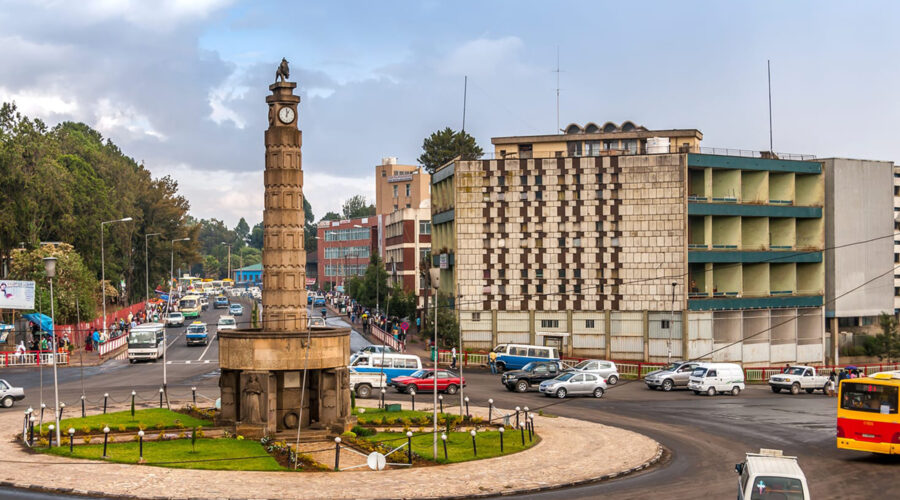01. Arrival in Addis Ababa. Transfer to the chosen hotel & relax at the hotel.
Afternoon visit Entoto mountain with views over the capital and the National museum, where Lucy is visited.
Lunch restaurant in town. Dinner & ON (overnight) hotel.
02. Charter or helicopter flight to Bahirdar.
Check in hotel and have your breakfast.
Then make a boat excursion on lake Tana to visit a beautiful monastery over its islands (Ura Kidane Mehret) and the Blue Nile source
Afternoon visit the Blue Nile falls.
Or you can choose just to relax at the hotel where a spa is available for massage and other treatment. At 06:00 pm enjoy the sunset with a sun downer.
Meals & ON hotel in Bahirdar
03. Helicopter flight to Gondar, the African Camelot, with spectacular views over lake Tana, Amhara people villages and the region.
Ones in Gondar visit the castles compound and Debre Birhan Selasie church (light of Trinity) with wonderful murals.
Proceed your helicopter flight to the Semien mountains.
Admire these spectacular views & flora, endemic animals as the Gelada baboons, Walia Ibex, Lammergeyer and more.
Relax then at the Limalimo lodge (or Semien lodge).
At 06:00 pm have a sun downer with fantastic views.
04. Helicopter flight to Lalibela admiring spectacular views over the Semien mountains.
Ones in Lalibela visit some of the rock-hewn churches, built in the 12th century.
Later afternoon fly back to Addis Ababa.
Dinner & ON Sheraton hotel (or similar)
05. Helicopter flight to Omo valley.
The Lower Omo Valley in Ethiopia is one of the most unique regions not only in Africa but in the world. This lush, picture-perfect region is home to so many different peoples. The remoteness of the Lower Omo Valley also means that for the most part, they have been able to retain their cultural integrity.
Reach the air strip of Murulle, where your vehicle/s will wait you.
Enjoy your day exploring the Karo people and their village and cultures.
The Karo, or Kara, are a Nilotic ethnic group in Ethiopia famous for their body painting. They are also one of the smallest tribes in the region being is a small tribe with an estimated population between 1.000 and 3.000. They live along the east banks of the Omo River in southern Ethiopia and practice flood retreat cultivation. The crops that are grown by them are sorghum, maize and beans. Only small cattle are kept because of the tsetse flies. These flies are large and consume the blood of vertebrate animals.
The Karo people differentiate themselves from many of the neighboring tribes by excelling specifically in body and face painting. They paint themselves daily with colored ochre, white chalk, yellow mineral rock, charcoal, and pulverized iron ore, all natural resources local to the area. The specific designs drawn on their bodies can change daily and vary in content, ranging from simple stars or lines to animal motifs, such as guinea fowl plumage, or to the most popular – a myriad of handprints covering the torso and legs.
Both the Karo and the Hamar men use clay to construct elaborate hairstyles and headdresses for themselves, signifying status, beauty, and bravery.
Meals and overnight at the tented lodge in Karo (or otherwise at the Emerald lodge Turmi www.emeraldresortandlodge.com) at the special designed VIP bungalows resembling the traditional people houses.
06. Morning remaining visits of the Karo people.
After lunch drive to Turmi, to visit the very colorful and interesting Hamar people.
Also well known as the Hamar or Hammer, they are one of the most known tribes in Southern Ethiopia. They inhabit the territory east of the Omo River and have villages in Turmi and Dimeka. They are cattle herders and practice agriculture.
Very colorful bracelets and beads are worn in their hair and around their waists and arms. The practice of body modification is used by cutting themselves and packing the wound with ash and charcoal.
Some of the women wear circular wedge necklaces indicating that they are married.
Men paint themselves with white chalk to prepare for a ceremony.
Hair ornaments worn by the men indicate a previous kill of an enemy or animal.
The traditional bull jumping is a rite of passage for men coming of age. The event last three days and involves only castrated cattle. The man must jump over a line of 10 to 30 bulls three times completely nude without falling. If this task is complete, the man joins the ranks of the Maza. Maza are other men that have successfully completed the bull jumping event and have higher social level, can participate to elders meeting, can marry and more.
During this ceremony, the women of the tribe provoke the maza to whip them on their bare backs. The scars are a symbol of devotion to the men and are encouraged by the tribe.
Night dancing called Evangadi is also a Hamer tradition.
The Hammers have unique huts that are made up of mud, wood and straw.
Dinner and overnight at the very characteristic Emerald lodge or back at your tented lodge in Karo.
07. MON. Morning go to visit another Hamer village. Then walk with the Hamer people to the colorful Turmi’s village weekly market. This is the Monday’s market of Hamer, Dassanech, Karo and Tsemay people.
Enjoy this vibrant market, meet different people and see how they merchandise.
The Hamer are one of the few tribes that do not plant crops. Instead, they exchange their cows, sheep, and goats for sorghum and maize to make porridge. Other than that, they eat only meat, milk, and blood from their animals. However, there are some things that just can’t be purchased with livestock. When money is needed, they sell their animals or products from their animals at weekly markets held around the region.
Back for lunch at Emerald lodge.
Afternoon charter or helicopter flight back to Addis Ababa.
ON Sheraton or similar hotel.
08. Morning (9am from the hotel) make a tour of the capital: Unity Park is established in 2019. The park is located at the Grand Palace in Addis Ababa, Ethiopia, a compound that has been a seat of state for more than a century. The total land coverage of the grand palace is 40 acres and it contains myriads of historical buildings and plants that date back to the time of emperor Menelik II, the founder of the Grand Palace.
In the afternoon relax at your hotel having day use room till 18 hrs.
Evening you will have fare well dinner in one of the Ethiopian restaurant for cultural dances from the different ethnic groups.
Then transfer to the airport for flight back home.
+251 96 632 8750
info@aquilatourism.com


